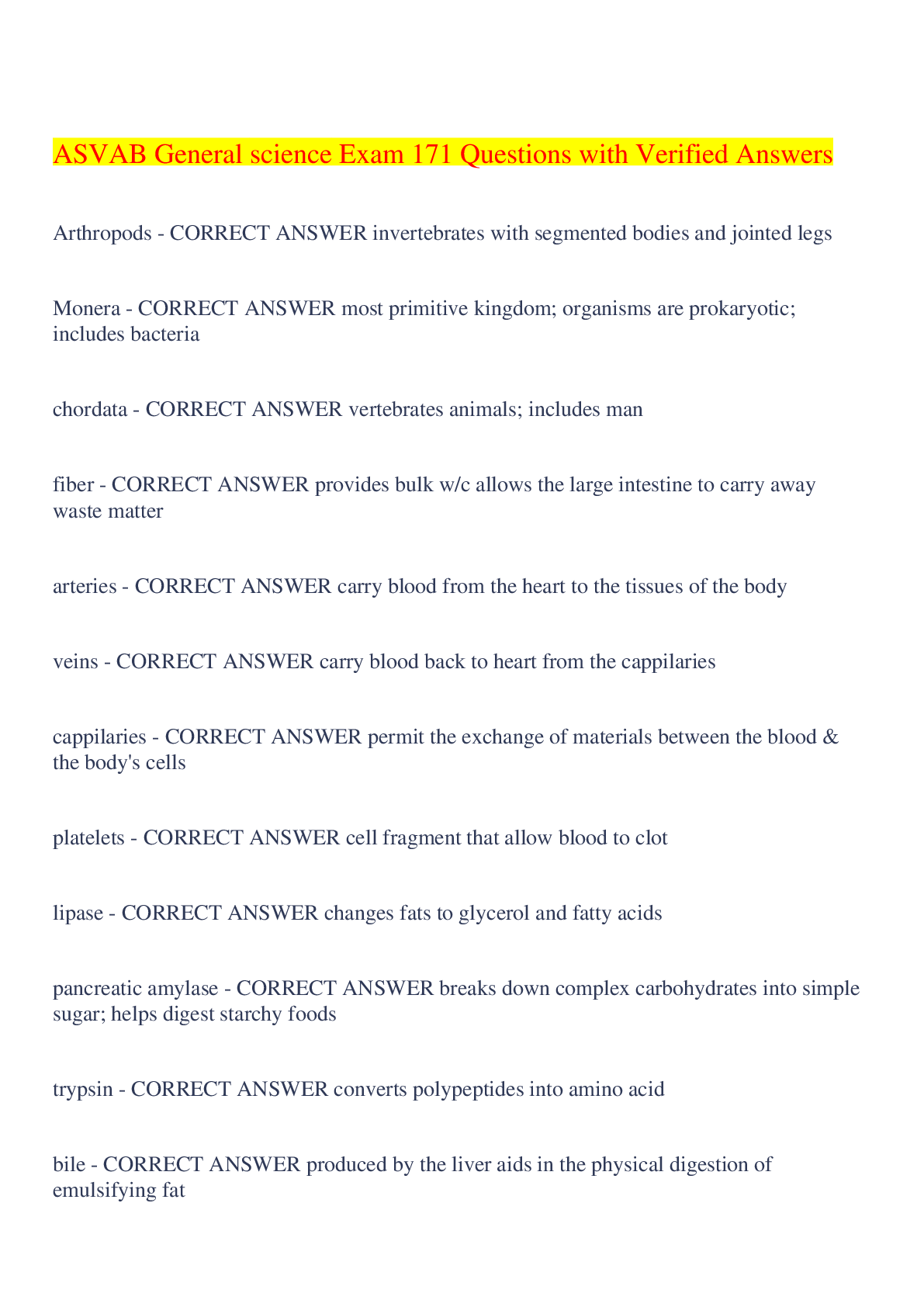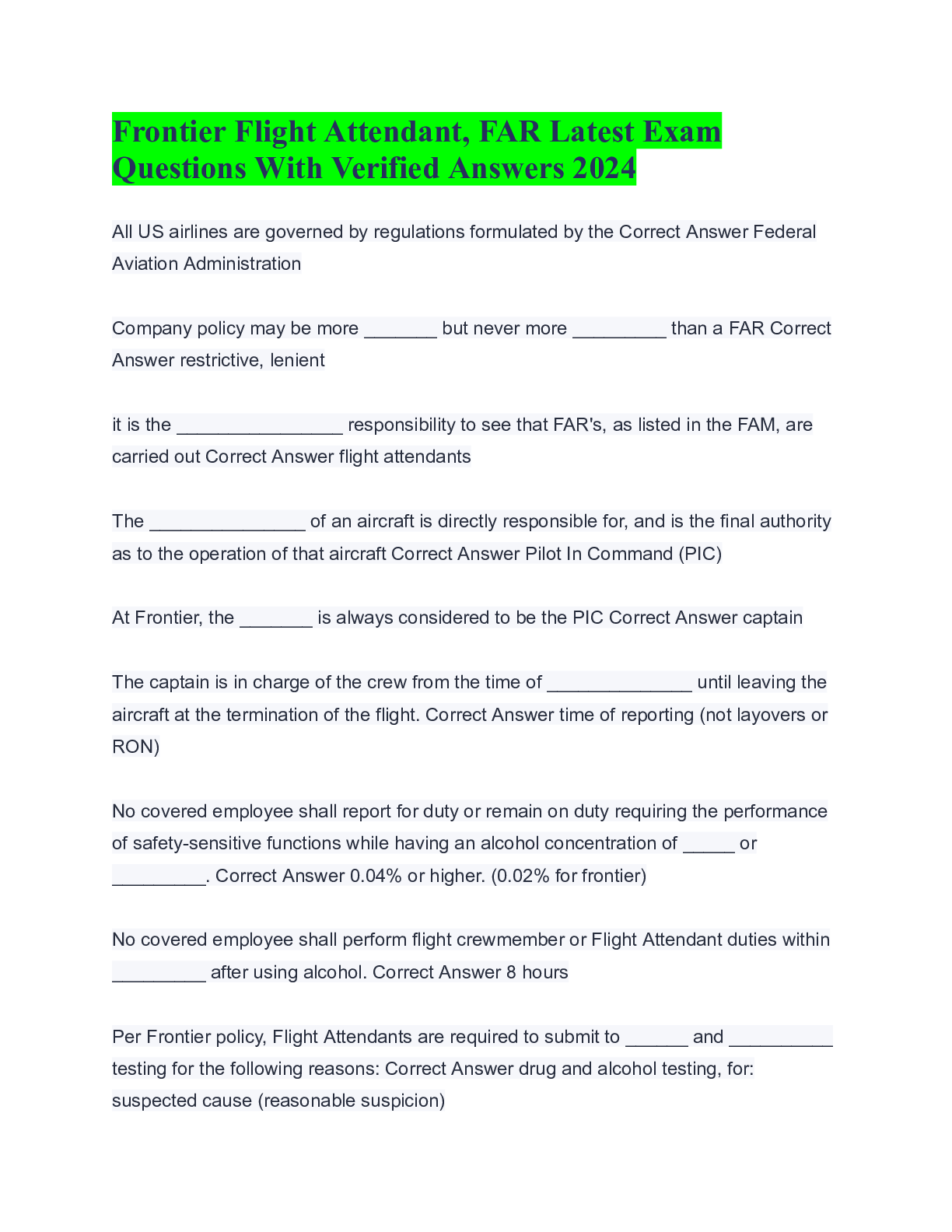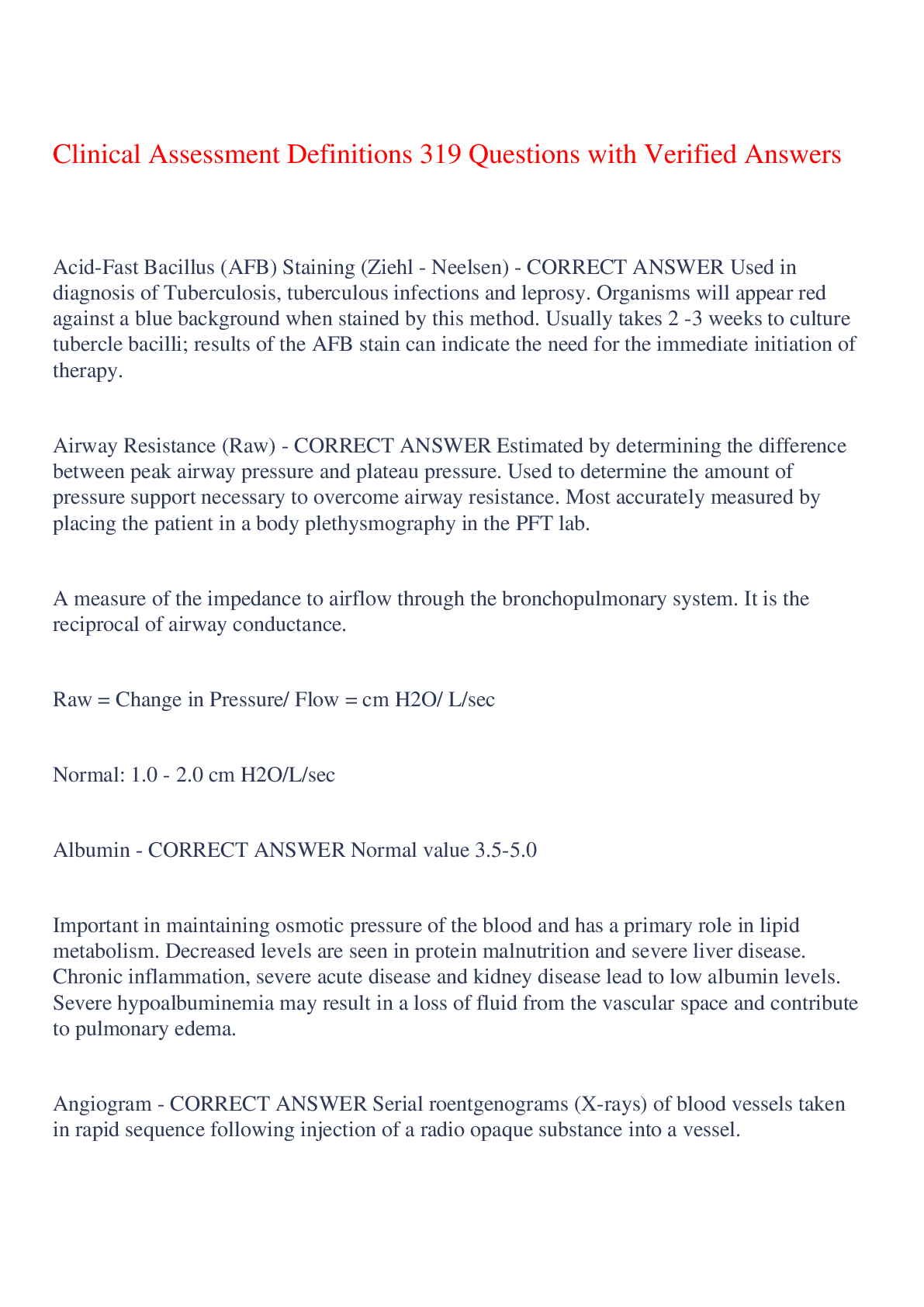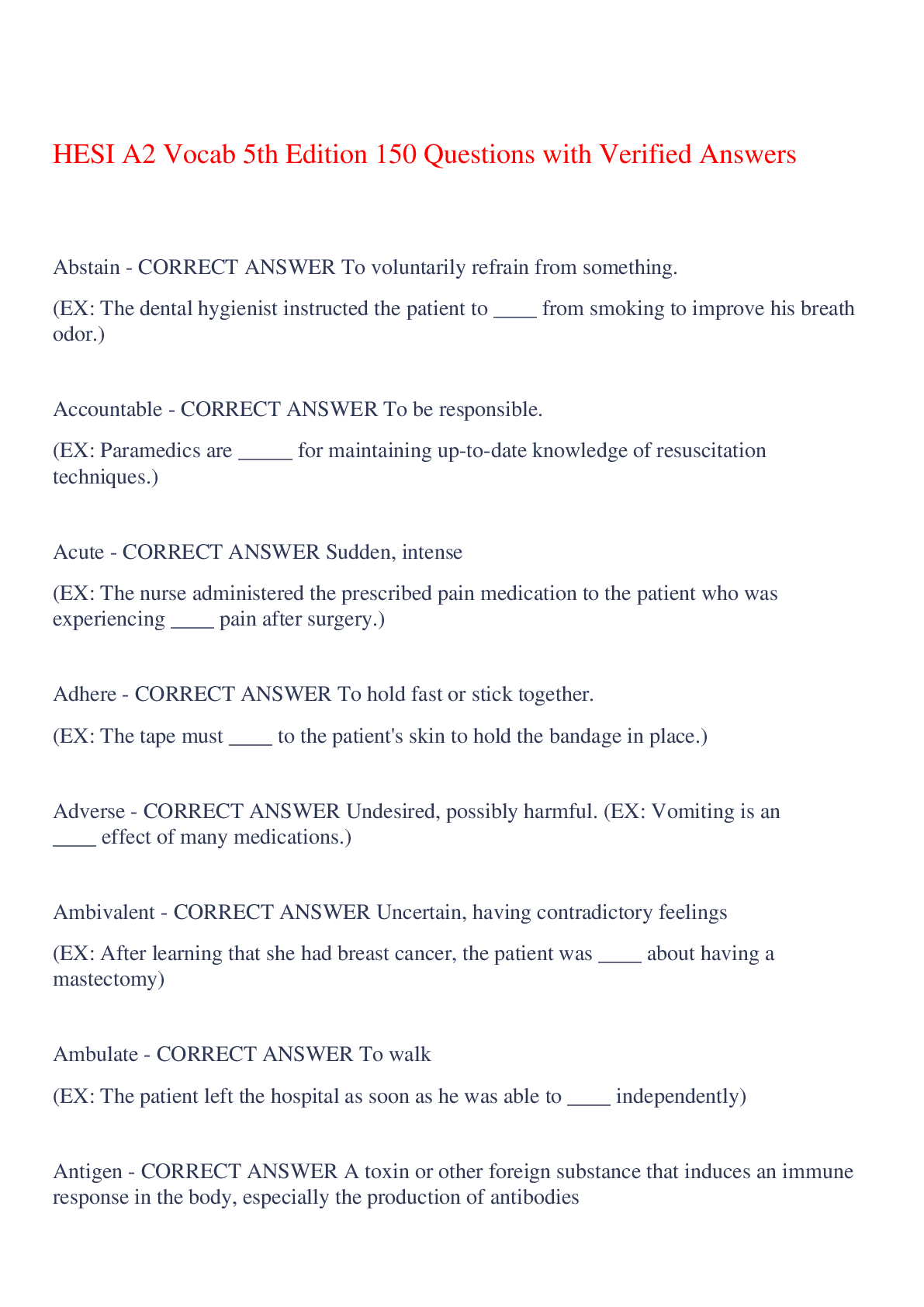Education > EXAM > ASVAB General science Exam 171 Questions with Verified Answers,100% CORRECT (All)
ASVAB General science Exam 171 Questions with Verified Answers,100% CORRECT
Document Content and Description Below
ASVAB General science Exam 171 Questions with Verified Answers Arthropods - CORRECT ANSWER invertebrates with segmented bodies and jointed legs Monera - CORRECT ANSWER most primitive kingdom; or... ganisms are prokaryotic; includes bacteria chordata - CORRECT ANSWER vertebrates animals; includes man fiber - CORRECT ANSWER provides bulk w/c allows the large intestine to carry away waste matter arteries - CORRECT ANSWER carry blood from the heart to the tissues of the body veins - CORRECT ANSWER carry blood back to heart from the cappilaries cappilaries - CORRECT ANSWER permit the exchange of materials between the blood & the body's cells platelets - CORRECT ANSWER cell fragment that allow blood to clot lipase - CORRECT ANSWER changes fats to glycerol and fatty acids pancreatic amylase - CORRECT ANSWER breaks down complex carbohydrates into simple sugar; helps digest starchy foods trypsin - CORRECT ANSWER converts polypeptides into amino acid bile - CORRECT ANSWER produced by the liver aids in the physical digestion of emulsifying fat cerebellum - CORRECT ANSWER concerned with the mascular coordination of the brain medulla - CORRECT ANSWER connection between the brain and the spinal cord; controls involuntary actions spinal cord - CORRECT ANSWER carry impulses; control center for many simple reflexes somatic nervous system - CORRECT ANSWER part of the peripheral nervous system; sending sensory information; controls voluntary actions autonomic nervous system - CORRECT ANSWER part of the peripheral nervous system; regulates involuntary activities meiosis - CORRECT ANSWER process by which gametes are created protista - CORRECT ANSWER simplest eukaryotes (cells have nuclei) ex: slime, water slime molds fungi - CORRECT ANSWER decomposers (saprothrops) ; includes mushrooms ecology - CORRECT ANSWER study of interrelationships between organisms & their physical surroundings biosphere - CORRECT ANSWER zone of planet earth where life naturally occurs, including land, water & air biome - CORRECT ANSWER species bound together by similar climate, vegetation & animal life ecosystem - CORRECT ANSWER system made up of a community of animals, plants as well as the non-living geology - CORRECT ANSWER deals with the history and composition of the earth and its life outer core - CORRECT ANSWER 2,300 km thick liquid inner core - CORRECT ANSWER 1,200 km radius solid richter scale - CORRECT ANSWER use to measure the intensity of the earthquake igneous rock - CORRECT ANSWER formed from hardening of molten rock or magma, w/c is called lava when reaches the surface of the earth ex: granite, pumice, basalt, obsidian sedimentary rock - CORRECT ANSWER formed by sedimentation or gradual depositing of small bits of rock, clay & other materials ex: shale, sandstone, gypsum, dolomite, coal metamorphic rock - CORRECT ANSWER formed when existing rock material is altered through temperature, pressure, or chemical processes ex: marble, slate, gneiss, quartzite precambrian eon - CORRECT ANSWER period before the fossil record began meteorology - CORRECT ANSWER study of weather, atmosphere, & atmospheric phenomena troposphere - CORRECT ANSWER lowest level of the atmosphere where all weather takes place. here found the 79% nitrogen & 21% oxygen stratosphere - CORRECT ANSWER above troposphere and jet stream where airflow is mostly horizontal; here found the ozone layer; 60 degrees celcius ozone layer - CORRECT ANSWER absorbs ultraviolet radiation from the sun mesosphere - CORRECT ANSWER above the stratosphere where we see "falling stars", meteors that fall to the earth & burn up in the atmosphere; 90 degrees celcius thermosphere - CORRECT ANSWER outermost layer of the earth; above mesosphere; 2000 degrees celcius at its upper limit sun - CORRECT ANSWER classified as a "G2V star" or "yellow dwarf" asteroids - CORRECT ANSWER a.k.a. "meteoroids", when they fall into the earth's gravitational field, they are seen as falling stars called "meteors" comets - CORRECT ANSWER sometimes called dirty snowballs or icy mudballs volume - CORRECT ANSWER measurement of three-dimensional space physics - CORRECT ANSWER deals with the properties, changes & interactions of matter & energy work - CORRECT ANSWER force exerted on an object times the distance moved in the direction of the force newton - CORRECT ANSWER unit of force joule - CORRECT ANSWER unit of work power - CORRECT ANSWER rate at which work is performed watt - CORRECT ANSWER unit of power newton's first law of motion - CORRECT ANSWER an object at rest tends to stay at rest, an object in motion tends to stay in motion unless acted upon by an unbalanced force friction - CORRECT ANSWER force that resists relative motion between two bodies in contact newton's second law of motion - CORRECT ANSWER "law of inertia" the greater the mass, the greater the force needed to overcome its inertia newtons' third law of motion - CORRECT ANSWER for every action, there is an equal and opposite reaction newton's law of gravitation - CORRECT ANSWER all objects in the universe attract each other w/an equal force that varies directly as a product of their masses. this force is known as "gravity" sound waves - CORRECT ANSWER produced when an object vibrates, disturbing the medium around it doppler effect - CORRECT ANSWER occurs when either the source of the sound waves, the listener, or both are moving gamma rays - CORRECT ANSWER most active radiant energy refractive index - CORRECT ANSWER ratio by which light is slowed down law of reflection - CORRECT ANSWER angle of incidence is equal to the angle of reflection concave mirror - CORRECT ANSWER converging mirror convex mirror - CORRECT ANSWER diverging mirror concave lens - CORRECT ANSWER one that is thicker on the edges than it is in the middle; also called "diverging lens" convex lens - CORRECT ANSWER one that is thicker in the middle than on the edges; also called "converging lens" conduction - CORRECT ANSWER simplest method of heat transfer; it is accomplished by direct contact such as placing your finger on a hot iron convection - CORRECT ANSWER transfer of heat unevenly in a liquid or gas, lowering the density of the heated liquid or gas, w/c causes it to rise & the cooler liquid or gas to fall radiation - CORRECT ANSWER occurs when electromagnetic waves transmit heat, the heat we get from the sun is called like this element - CORRECT ANSWER a substance that cannot be separated into different substances by ordinary chemical methods atom - CORRECT ANSWER smallest component of an element that still retains the properties of the element molecule - CORRECT ANSWER smallest particle of an element or compound that can exist in the free state & still retains the characteristic of an element or compound acid - CORRECT ANSWER substance that gives up positively charged hydrogen ions(H+) when dissolved in water ex: vinegar, lemon juice base - CORRECT ANSWER substance that gives up negative charged hydroxyl ions(OH-) when dissolved in water. tastes bitter ex: soap, baking soda pH - CORRECT ANSWER number from 0 to 14. less than 7 are "acidic" greater then 7 are "basic" sublimation - CORRECT ANSWER the process by which a solid converts directly into a gas; example of endothermic change heat - CORRECT ANSWER can be described as a from of energy silver - CORRECT ANSWER best conductor of heat group - CORRECT ANSWER in the periodic elements, it defines the number of outer electrons found in the atoms of its element cold front - CORRECT ANSWER when a cold air mass meets and replaces the warm air mass alveoli - CORRECT ANSWER this is where the blood receives oxygen during the process of respiration cellulose - CORRECT ANSWER main difference between plant and animal cell, component of the cell wall of plants lithosphere - CORRECT ANSWER where you can find 30 plates of continental landmasses, a rigid layer made up of the uppermost part of the mantle and the crust ionosphere - CORRECT ANSWER The lower part of the thermosphere, where electrically charged particles called ions are found. thin layer of ozone that reflects 27 1/2 days - CORRECT ANSWER moon completes an entire revolution around the earth point of absolute zero - CORRECT ANSWER coldest point at w/c all matter stop moving decomposition - CORRECT ANSWER occurs when hydrogen peroxide is broken down into separate elements halley's comet - CORRECT ANSWER composed mostly of ice & rocks biofact - CORRECT ANSWER object found at an archaeological site signifying that it was once a living organism tundra - CORRECT ANSWER coldest; has treeless plains as the ground is frozen taiga - CORRECT ANSWER below the tundra; it has short & moist summer but long & dry winter; mostly evergreen trees can survive in this climate deciduous forests - CORRECT ANSWER have a moderate climate where tress shed their leaves every year grasslands - CORRECT ANSWER more grass than tress beacuse rainfall is not enough tropical rainforests - CORRECT ANSWER located near the equator when the sun strikes directly; it has a lots of rainfall; trees have thick leaves marine - CORRECT ANSWER aquatic environment is the largest biome; covers 3/4 of the entire earth phylum porifera - CORRECT ANSWER (sponges) porous marine animals that lack a bony structure phylum coelanterata - CORRECT ANSWER more complex than sponges; ex: jellyfish, coral phylum platyhelminthes - CORRECT ANSWER (flatworms) have organs:; ex: tapeworm phylum nematoda - CORRECT ANSWER (roundworms) parasites that contain digestive tracts with two openings ex: hookworm phylum annelida - CORRECT ANSWER long, round & segmented; ex: earthworm phylum mollusca - CORRECT ANSWER (mollusks) soft-bodied animals protected by a hard covering phylum echinodermata - CORRECT ANSWER spiny marine animals that have five or more legs branching out into radial symmetry; ex: starfish systolic - CORRECT ANSWER contraction stage diastolic - CORRECT ANSWER rest stage pulmonary artery - CORRECT ANSWER the only artery that doesnt carry oxygenated blood diffusion - CORRECT ANSWER happens when oxygen and nutrients are transferred from the blood tothe cells estrogen - CORRECT ANSWER produced by the ovaries light year - CORRECT ANSWER used to measure distance magnifying lens - CORRECT ANSWER you can use this to start a fire with the aid of the sun alcohol - CORRECT ANSWER substance that is readily absorbed through the walls of the stomach methane - CORRECT ANSWER what will be loss if the aeration of water will produced CO2 - CORRECT ANSWER correct formula for dry ice renal system - CORRECT ANSWER urine system; responsible for filtering out impurities from the blood & excreting them refraction - CORRECT ANSWER the bending of a wave caused by a change in its speed as it moves from one medium to another nucleotides - CORRECT ANSWER smaller parts of nucleic acid commensalism - CORRECT ANSWER the relation between two different kinds of organisms when one receives benefits from the other without damaging it angiosperm - CORRECT ANSWER produces flowers catalysts - CORRECT ANSWER substance that hasten chemical reaction time without themselves undergoing change anemometer - CORRECT ANSWER measures the wind speed endocrine system - CORRECT ANSWER responsible for releasing hormones into the blood stream B - CORRECT ANSWER The function of an enzyme is to (A) Provide energy for a chemical reaction (B) Speed up a chemical reaction (C) Become hydrolyzed during a chemical reaction (D) Serve as an inorganic catalyst B - CORRECT ANSWER A one-kilogram mass is dropped from a height of 1 meter. Its kinetic energy just before it hits the ground is about (A) 1 joule (B) 10 joules (C) 100 joules (D) 1,000 joules D - CORRECT ANSWER The DNA of a cell is found mainly in its (A) Membrane (B) Cytoplasm (C) Vacuoles (D) Chromosomes B - CORRECT ANSWER Most cells without a cell wall also lack (A) Mitochondria (B) Chloroplasts (C) Cell membranes (D) Vacuoles B - CORRECT ANSWER The cells that can easily be scraped from the lining of the mouth make up (A) Connective tissue (B) Epithelial tissue (C) Supporting tissue (D) Voluntary tissue D - CORRECT ANSWER The end product of protein digestion consists of (A) Glucose (B) Fatty acids (C) Glycerol (D) Amino acids C - CORRECT ANSWER Blood circulation from the lungs goes directly to the (A) Legs (B) Head (C) Heart (D) Digestive system A - CORRECT ANSWER The glucose content of the blood is regulated by (A) Insulin and adrenaline (B) Nerve stimulation (C) ACTH (D) Progesterone C - CORRECT ANSWER The ocean current that extends from Florida across the Atlantic Ocean to Europe is (A) El Nino (B) the Japan Current (C) the Gulf Stream (D) the Southwest countercurrent C - CORRECT ANSWER The member of the solar system with the shortest period of solar revolution is (A) Io (B) Jupiter (C) Mercury (D) Hailey's Comet B - CORRECT ANSWER The type of meteorological system with the highest velocity winds is the (A) Thunderstorm (B) Tornado (C) Hurricane (D) Sea breeze C - CORRECT ANSWER A 120 volt electrical power supply produces two amperes to the load. The power delivered is (A) 60 watts (B) 60 ohms (C) 240 watts (D) 240 ohms C - CORRECT ANSWER Frictional forces usually do NOT (A) Oppose motion (B) Decrease kinetic energy (C) Increase potential energy (D) Produce wear A - CORRECT ANSWER A magnifying glass is what kind of lens used on objects how far away? (A) Convex lens used closer than one focal length (B) Concave lens used closer than one focal length (C) Convex lens used beyond one focal length (D) Concave lens used beyond one focal length D - CORRECT ANSWER The mass of one cubic meter of water is approximately (A) 1 kilogram (B) 10 kilograms (C) 100 kilograms (D) 1,000 kilograms D - CORRECT ANSWER A magnetic compass points in the direction of (A) True north (B) The geographic North Pole (C) The magnetic North Pole (D) The local magnetic field D - CORRECT ANSWER The half-life of iodine-131 (I-131 for short) is 8 days. Approximately how long would it take for 16 milligrams of I-131 to decay to a half milligram of I-131? (A) 4 days (B) 8 days (C) 14 days (D) 32 days B - CORRECT ANSWER A gaseous product of the fermentation of sugar is (A) Carbon monoxide (B) Carbon dioxide (C) Sulfur dioxide (D) Oxygen B - CORRECT ANSWER Nitrates can be very useful as (A) Detergents (B) Fertilizers (C) Fuels (D) Solvents C - CORRECT ANSWER The number of atoms in a molecule of CuSO4 5H2O is (A) 15 (B) 18 (C) 21 (D) 29 D - CORRECT ANSWER Which substance can be used to treat drinking water of questionable purity? (A) Ammonia (B) Chlorine (C) Hydrogen Chloride (D) Iodine A - CORRECT ANSWER A viral infection in humans characterized by a very long time between the initial exposure and the exhibition of the symptoms is (A) AIDS (B) Measles (C) Pneumonia (D) Chicken pox A - CORRECT ANSWER The beneficial relationship between termites and the protozoa that inhabit their digestive systems is called (A) Symbiosis (B) Parthenogenesis (C) Mitosis (D) Phagocytosis C - CORRECT ANSWER Erosion and depletion are problems associated with (A) Blood circulation (B) The ozone layer (C) Soil conservation (D) Cardiovascular exercise B - CORRECT ANSWER The particle with a ___ charge in the nucleus of an atom is a(n) ___ (A) positive, electron (B) positive, proton (C) negative, neutron (D) neutral, positron B - CORRECT ANSWER The four forces that act on an aircraft in flight are (A) lift, thrust, friction, and inertia (B) lift, gravity, thrust, and drag (C) thrust, vector, speed, and fluid density (D) lift, downdraft, thrust, vector B - CORRECT ANSWER Electrons have a ___ charge (A) Positive (B) Negative (C) Neutral (D) Variable A - CORRECT ANSWER Antibodies (A) identify and neutralize foreign objects inside the body (B) bond with antigens to keep the body's hormones balanced (C) prevent infection by blocking access to the circulatory system (D) are produced by the endocrine system C - CORRECT ANSWER A gamete is a cell that (A) fuses with a zygote during fertilization (B) provides nutritional support to a developing fetus (C) fuses with another gamete during fertilization (D) fuses with a spermatid before fertilization D - CORRECT ANSWER What is the smallest part of matter that retains the chemical properties characteristic of a particular element? (A) Isotope (B) Molecule (C) Electron (D) Atom C - CORRECT ANSWER The average distance of the Earth from the sun is about (A) 240,000 miles (B) 19 million miles (C) 93 million miles (D) 240 million miles B - CORRECT ANSWER Humans have ___ pairs of chromosomes (A) 13 (B) 23 (C) 46 (D) 47 C - CORRECT ANSWER What is the scientific study of human culture called? (A) Sociology (B) Archaeology (C) Anthropology (D) Scientology A - CORRECT ANSWER What are the five major layers of Earth's atmosphere, in order from the Earth's surface upward (A) troposphere, stratosphere, mesosphere, thermosphere, exosphere (B) troposphere, stratosphere, ionosphere, exosphere (C) troposphere, tropopause, ionosphere, stratosphere, exosphere (D) mesosphere, stratosphere, troposphere, tropopause C - CORRECT ANSWER Which of the following is not usually a gas at room temperature? (A) Oxygen (B) Fluorine (C) Sulfur (D) Argon D - CORRECT ANSWER A substance that speeds up a chemical reaction is a(n) (A) Accelerator (B) Adipose (C) Compound (D) Catalyst C - CORRECT ANSWER Spiders are (A) Marsupials (B) Insects (C) Arachnids (D) Annelids B - CORRECT ANSWER What type of blood vessel carries blood from the other parts of the body to the heart? (A) Capillaries (B) Veins (C) Arteries (D) Aortas C - CORRECT ANSWER Which is the correct sequence of objects in the solar system, moving outward from the sun? (A) Mercury, Venus, Earth, asteroid belt, Mars, Jupiter (B) Mars, asteroid belt, Jupiter, Saturn, Neptune (C) Mars, asteroid belt, Jupiter, Saturn, Uranus (D) Mars, asteroid belt, Saturn, Jupiter, Neptune C - CORRECT ANSWER A person's appearance resulting from his or her genetic makeup is called the person's (A) Genotype (B) Individual apparent mutation (C) Phenotype (D) Source of heredity B - CORRECT ANSWER When a plant performs photosynthesis, it produces ___ as a by-product (A) Carbon dioxide (B) Oxygen (C) Water (D) Methane C - CORRECT ANSWER The speed of light in a vacuum is about (A) 186,000 miles per hour (B) 186,000 kilometers per hour (C) 186,000 miles per second (D) 186,000 feet per second squared A - CORRECT ANSWER When atoms and molecules pass thermal energy by direct contrast, it is known as (A) Conduction (B) Convection (C) Insulation (D) Swapping paint B - CORRECT ANSWER The basic unit of heat is the calorie, which is the amount of heat needed to (A) Raise the temperature of 1 ounce of water 1 degree Fahrenheit (B) Raise the temperature of 1 gram of water 1 degree Celsius (C) Change the temperature of 1 kilo of water 1 degree Kelvin (D) Lower the temperature of 1 quart of water 1 degree Celsius C - CORRECT ANSWER The temperature of the atmosphere falls during the nighttime hours because (A) The side of the earth not facing the sun loses heat by convection (B) The side of the earth facing the sun loses heat by evaporation (C) The side of the earth not facing the sun loses heat by radiation (D) People set their thermostats lower when they go to bed B - CORRECT ANSWER The number of protons in an atom's nucleus determines its (A) Half-life (B) Atomic number (C) Orbital shell diameter(s) (D) Magnetic resonance B - CORRECT ANSWER Kwashiorkor would probably be caused by a diet deficient in (A) Fruits and vegetables (B) Meat, eggs, and dairy products (C) Yellow and green leafy vegetables (D) Starchy plants C - CORRECT ANSWER A vibrating tuning fork, placed in a vacuum under a bell jar, will (A) Have the pitch of its sound raised (B) Have the pitch of its sound lowered (C) Be inaudible (D) Crack the thin glass of the bell jar D - CORRECT ANSWER What are examples of human diseases caused by bacteria? (A) Tuberculosis, diphtheria, and anthrax (B) Cholera, rickets, and typhoid fever (C) Influenza, cholera, and scurvy (D) Cancer, tuberculosis, and plague C - CORRECT ANSWER The "twinkling" of stars in the night sky is caused by (A) Doppler shift over light-years of distance (B) Solar flares on the surface of the star in question (C) Variations in the Earth's atmosphere (D) Wavelength perturbations caused by solar wind B - CORRECT ANSWER When an airplane is in flight, the air pressure on the bottom surface of the wing is (A) Less than on the top surface (B) More than on the top surface (C) Either more or less than the top surface, depending on the speed of the airplane (D) The same as on the top surface D - CORRECT ANSWER An amphibian can best be described as (A) A smooth-skinned vertebrate mammal that can live in water or on land (B) An oviparian capable of living in wetlands or in the desert (C) A cold-blooded invertebrate that can live both on land and in water (D) A cold-blooded, smooth-skinned vertebrate capable of living both on land and in water D - CORRECT ANSWER The most accurate description of the earth's atmosphere is that it is comprised of (A) 78% oxygen, 19% nitrogen, and 2% carbon dioxide with traces of nitrogen, water vapor, and dust particles (B) 3% water vapor, 78% ozone, and 20% nitrogen (C) 20% oxygen, 77% hydrogen, 3% carbon dioxide, and some water vapor (D) 21% oxygen, 78% nitrogen, .03% carbon dioxide, trace amounts of rare gases, water vapor, and some dust particles A - CORRECT ANSWER The apogee of an orbiting object refers to (A) The point in an orbit that is furthest from the body being orbited (B) The point in an orbit that is nearest to the body being orbited (C) The point where breakaway velocity is initially achieved (D) The point where gravity has the most effect on the orbiting body A - CORRECT ANSWER The reaction between sodium, metal, and water can be classified as (A) Single replacement (B) Double replacement (C) Decomposition (D) Synthesis [Show More]
Last updated: 5 months ago
Preview 1 out of 22 pages
Instant download

Instant download
Reviews( 0 )
Document information
Connected school, study & course
About the document
Uploaded On
Dec 22, 2023
Number of pages
22
Written in
Additional information
This document has been written for:
Uploaded
Dec 22, 2023
Downloads
0
Views
41





























